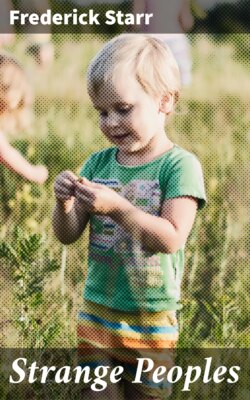Читать книгу Strange Peoples - Frederick Starr - Страница 9
На сайте Литреса книга снята с продажи.
VI.
THE PEOPLES OF EUROPE: FAIR WHITES.
ОглавлениеTable of Contents
Europe is the continent of white peoples. While there are white peoples in other continents, they are there as invaders. But even among the whites of Europe itself there are differences. Most of the Northern peoples, like the Swedes, Dutch, Russians, Germans, are light peoples, with delicate skin, light hair, blue eyes, and rather long heads. They are mostly tall in stature. The Southern peoples are dark—Spaniards, Portuguese, Italians, Greeks, are all brunettes. They are shorter, more slender, with dark skin, dark eyes, and black hair. In the region between these two types of European whites there are peoples of medium stature, rather stout, somewhat dark, with broad, round heads. Mr. Ripley names these three kinds of Europeans—Teutonic, Mediterranean, and Alpine peoples. We will speak simply of light whites and dark whites. All the Europeans we have named speak languages that are much alike, belonging to a group of languages to which the name Aryan is given. There are, however, some peoples of Europe who do not speak Aryan languages. Such are the Basques, Finns, Lapps, and Turks.
All the fair whites are so like ourselves that it will hardly do to call them Strange Peoples. Yet we would find many curious things even in those who are most like ourselves, as the Hollanders. You know something about little Holland? It is a low, flat country, and much of it was formerly under the sea. The industrious Hollanders have built great dikes or walls to keep the sea back, and, by pumping out the water, reclaimed the land. A rich and fertile land it is, intersected by a network of little canals. Everywhere you go in Holland you see windmills. Because the country is so low and flat, there are no rapid streams to furnish water-power for mills, so they must use the wind. At some places, like Zaandam, hundreds may be seen at once. With us windmills are simply for pumping water, but in Holland they do many kinds of work. Some are flouring mills, others are sawmills for cutting timber, others run oil presses, etc.
FISH-GIRL OF SCHEVENINGEN, HOLLAND (FROM A PHOTOGRAPH).
The fishing towns of Holland are interesting. Every traveller wants to see Vollendam and Scheveningen and the hamlets on the Island of Marken. The men and women in these towns are kind-hearted, simple people, who are proud of their own village and think their own dress finer than that of other towns. Each of these fishing villages has its characteristic costume. The men of the Island of Marken wear a close-fitting jacket which ends at the waist and great, baggy, knee pants. Marken women wear round, white caps, fitting the head closely, with an open-work border, and a bright waist, with striped sleeves, over the front of which is a square of handsomely embroidered cloth. Little girls all through Holland dress exactly like women. But for her child face you would take the little girl from Scheveningen to be a grown person. She wears a dainty white cap pinned on with two great round-headed pins. Her ample dress quite reaches the ground; her white apron is neatly tied, and her purple shawl, tightly wrapped about her shoulders, is demurely crossed, and the ends are tucked under her apron strings. She wears the common wooden shoes of the country. A crowd of boys running in such shoes over the hard paved roads makes a great clattering. On Sunday the wooden shoes of men and boys are usually fresh whitened; if their owners enter a house, they leave the shoes outside the door. I am sure you cannot guess what little Dutch boys do with old wooden shoes. They make capital little fishing boats out of them, which they sail on the canal. The real big fishing boats are really shaped very much like shoes too.
BOATS MADE FROM SHOES, HOLLAND (HAITÉ).
Edam cheese is one of Holland’s famous products. The people are wonderfully careful in making it. They take great care of the cows; when the weather is wet or the flies troublesome, they put blankets over them to protect them. The stables where they keep them are as clean as soap and water will make them; the stalls are made of handsomely planed wood, and there is a window at each one to let in light and to give the cows a chance to look out on the green meadows. The cheeses are made of cream and are pressed in clean, white, earthenware moulds, into the shape and size of cannon balls. They are then colored and sent to market. The greatest cheese market of Holland is at Alkmaar. Scores of boatfuls are there unloaded every market day. The market is at the water’s edge. The cheeses are colored orange or red, and are oiled and wiped till they shine. They are stacked in piles like cannon balls.
Among famous Dutch towns is Delft, where they make a beautiful white porcelain with blue designs, which is a favorite everywhere: then there is Schiedam, where they make “Schnapps,” or gin, which is as famous probably as the Delft ware, but not so praiseworthy; then there is Haarlem, famous for its flower gardens, its tulips and begonias; at Leiden there is a noble old university and a museum where one may see objects made and used by all the Strange Peoples we shall study and many more. Holland has had many great artists, and their works are preserved in the art galleries at Rotterdam, Leiden, The Hague, Haarlem, and Amsterdam. Holland was once the great commercial and naval nation of the world: that day is past, but her ships still sail all seas; the little kingdom is still a centre of intelligence, industry, and education, and the thrifty and wealthy Dutch are a worthy example of the Fair Whites.
